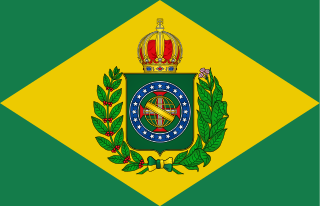
A corvette is a small warship. It is traditionally the smallest class of vessel considered to be a proper warship. The warship class above the corvette is that of the frigate, while the class below was historically that of the sloop-of-war. The modern types of ships below a corvette are coastal patrol craft, missile boat and fast attack craft. In modern terms, a corvette is typically between 500 tons and 2,000 tons, although recent designs may approach 3,000 tons, which might instead be considered a small frigate.

The Brazilian Navy is the naval service branch of the Brazilian Armed Forces, responsible for conducting naval operations. The Brazilian Navy is the largest navy in South America and in Latin America, and the second largest navy in the Americas, after the United States Navy.
V34, or similar, may refer to:

The Battle of the Riachuelo was a large and decisive naval battle of the Paraguayan War between Paraguay and the Empire of Brazil. By late 1864, Paraguay had scored a series of victories in the war, but on June 11, 1865, its naval defeat by the Brazilians on the Paraná River began to turn the tide in favor of the allies.
Bahia is a state in Brazil.

The Inhaúma class are a series of five corvettes operated by the Brazilian Navy. These ships were built in Brazil and designed with assistance from the German company Marine Technik. It was originally planned to build 12 to 16 ships but the economic situation in Brazil did not permit this and only five vessels were built. The first two ships were constructed at the Arsenal de Marinha in Rio de Janeiro, the second pair by Verolme. The programme was considerably delayed due to funding issues and the Brazilian Verolme yard's insolvency in 1991 which forced Júlio de Noronha and Frontin to be completed by Arsenal da Marinha. The first ship entered service in 1989 and the last in 2008. Three of the five ships have been taken out of service and one was sunk in a missile exercise in the Atlantic Ocean in 2016.

Six ships of the French Navy have borne the name Républicain ("Revolutionary"):

The Battle of the Tonelero Pass, also known as Passage of the Tonelero, was a battle fought near the cliff of Acevedo, in the west bank of the Paraná River, Argentina, on 17 December 1851, between the Argentine Confederation Army commanded by Lucio Norberto Mansilla and warships of the Brazilian Imperial Navy led by John Pascoe Grenfell.

Cv Barroso (V-34) is a corvette of the Brazilian Navy, and the lead ship of its sub class. The fifth Brazilian warship to be named after Admiral Francisco Manoel Barroso da Silva, Barroso was launched on 20 December 2002 and commissioned on 19 August 2008.

There have been at least three vessels that have served with the Brazilian Navy named Almirante Barroso, after Francisco Manuel Barroso, Baron of Amazonas:
Sixteen ships of the French Navy have borne the name Vénus in honour of the Roman goddess of love Venus:

The Arsenal de Marinha do Rio de Janeiro (AMRJ) is a military organization of the Brazilian Navy. It is located in Ilha das Cobras, at the Guanabara Bay, in the city of Rio de Janeiro. The Arsenal is the main maintenance center and naval base of the Brazilian Navy, involving the design, construction and maintenance of ships and submarines, not only for the Brazilian Navy, but also to friendly nations. The AMRJ provides shipbuilding services both for military strategic reasons, as economic ones, seeking nationalisation of components and the encouragement of domestic industry. Beside the AMRJ, the Brazilian Navy also has naval bases, that act in support of the Naval Districts, ships in transit or in specific technical areas. Among them are the Naval Base of Aratu, the Naval Base of Val-de-Cães and the River Base of Ladário.
HMS Dolphin was a screw sloop-of-war of the Royal Navy launched in 1882, used as school ship, and finally broken up in 1977.

The Imperial Brazilian Navy was the navy created at the time of the independence of the Empire of Brazil from the United Kingdom of Portugal, Brazil and the Algarves. It existed between 1822 and 1889 during the vacancy of the constitutional monarchy. The Navy was formed almost entirely by ships, staff, organizations and doctrines proceeding from the transference of the Portuguese Royal Family in 1808. Some of its members were native-born Brazilians, who under Portugal had been forbidden to serve. Other members were Portuguese who adhered to the cause of separation and German and Irish mercenaries. Some establishments created by King João VI were used and incorporated. Under the reign of Emperor Pedro II the Navy was greatly expanded to become the fifth most powerful navy in the world and the armed force more popular and loyal to the Brazilian monarchy. The republican coup d'état in 1889, led by army men, put an end to the Imperial Navy that fell into decay until the new century.
Several ships have been named Robert.
Several ships of the Chilean Navy have been named Chacabuco after the Battle of Chacabuco:

The steam corvette Jequitinhonha was a warship in the Imperial Brazilian Navy during the Paraguayan War. It took part in the Battle of Riachuelo.
At least four ships of the Brazilian Navy have borne the name Amazonas
At least two ships of the Brazilian Navy have borne the name Apa
At least two ships of the Brazilian Navy have borne the name Araguari
This page is based on this
Wikipedia article Text is available under the
CC BY-SA 4.0 license; additional terms may apply.
Images, videos and audio are available under their respective licenses.










